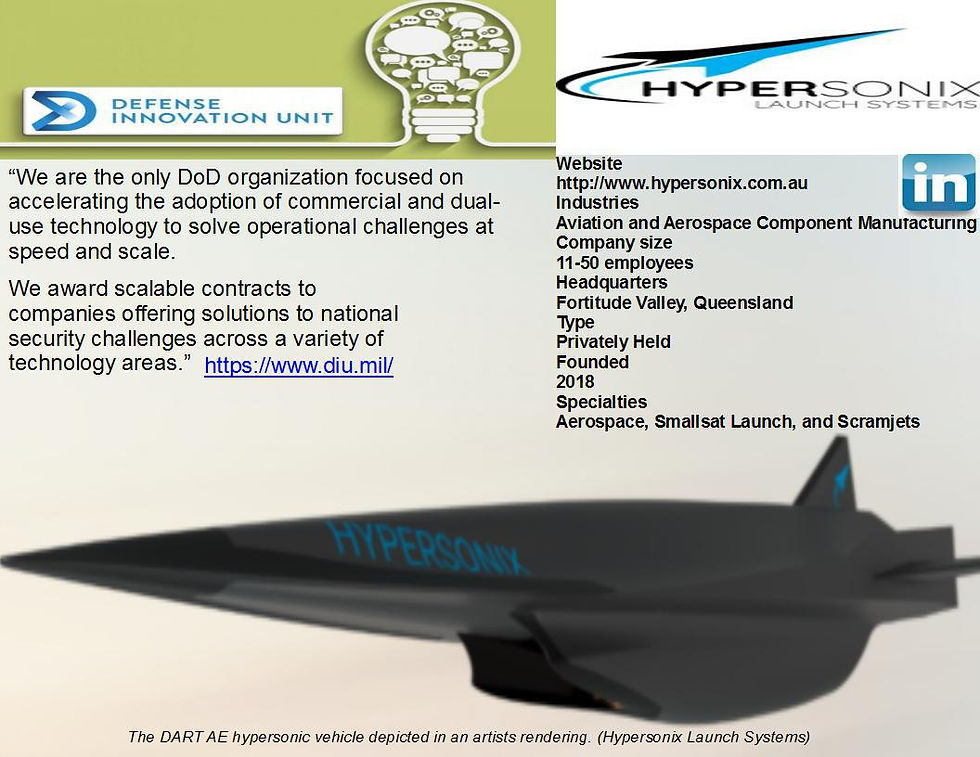Australian Startup Is U.S. Defense Innovation Unit Hypersonics’ Pick
- Ken Larson

- Apr 3, 2023
- 3 min read

“BREAKING DEFENSE” By Colin Clark
“A small Australian company has beaten out 62 competitors that include major US defense primes for a Defense Innovation Unit program meant to serve as a fast flying and reusable hypersonics test bed.
Hypersonix Launch Systems will develop a testing vehicle that can fly and maneuver between Mach 5 and Mach 7, the DIU contract requires. The first flight is expected next year, the company said in a press release.”
________________________________________________________________________________
“Hypersonics, of course, are a key focus of Pillar 2 of the AUKUS agreement, along with cyber, quantum and undersea technologies.
“This is our first major contract and a key step in our commercialisation process – we couldn’t be happier. This puts Australia one step closer to being a major player in the international space race,” David Waterhouse, managing director and co-founder of the company, said in a statement. “Our longer-term focus is to capture a slice of the emerging multi-billion-dollar commercial market for deployment of small satellites, but clearly Australia’s strategic defence allies see immediate potential in our technology.”
The Pentagon can transition this program to production contracts worth up to $500 million under DoD’s acquisition laws and rules. If this program broadens to production, it will be a singular success story for an Australian research and development effort, which often excel until they face the perils of the well-known valley of death. The lack of scale in the Lucky Country’s government enterprise makes success even more difficult than in the comparatively well-funded and huge market in the United States.
The DIU program, known as HyCAT (for Hypersonic and high-cadence testing capabilities) is designed to greatly speed hypersonic testing and lower the costs for testing the platforms, their components, as well as sensors, communication, navigation and guidance equipment and control. DART AE can carry a modular payload of up to 20 pounds.
As the Pentagon’s release about the contract says, current “testing is limited to land- and sea-based test ranges optimized for low-cadence and operationally-representative tests that replicate the trajectory and velocity of the hypersonic weapon system. However, testing is both costly, slow to iterate and test ranges are limited.”
The March 16 DIU release said that the DART AE platform “bypasses the most fuel-intensive phase of the launch process, reducing costs and offering increased flexibility in operating locations and schedule responsiveness.”
“The initiative for which Hypersonix has been engaged is designed to energize the innovative non-traditional/commercial ecosystem for supporting future hypersonic flight test capabilities. The goal is to build the necessary toolkit to significantly increase the tempo, and broaden the spectrum, of hypersonic flight tests to further accelerate learning and development,” Lt. Cdr. Tim Gorman, spokesman for the Office of Secretary of Defense in Washington, said in a statement.
In addition to awarding the program to a commercial company, DIU also believes the HyCAT program “represents a paradigm shift in viewing the hypersonic realm as a place for aircraft, not just missiles and weapons,” Maj. Ryan Weed, a program manager in DIU’s space portfolio, said in the DIU statement.
What makes Hypersonix, a four-year-old company, unique enough that it beat out so many competitors?
Its Hypersonix scramjet engine can be 3D printed using the extremely hard alloy known as Inconel, with some more exotic coatings for the vehicle’s exposed edges. It uses a mechanically simpler hydrogen system for thrust of its engine, which gives it variable speed control and huge range — a claimed range more than 1,000 kilometers on one kilo of hydrogen. And the complete DART AE system, which has no moving parts, is designed to be reusable.
Hypersonix co-founder Dave Waterhouse told Breaking Defense a year ago that the company had “actually 3D printed a working [hydrogen] scramjet engine,” which may well have appealed to DIU.
A second, unrelated DIU hypersonics contract has als0 been awarded to Fenix Space, San Bernardino, Calif., for its reusable tow-launch platform. It’s meant to improve the “efficiency and affordability of high-cadence test flights.”
Those awards are not the only hypersonics effort to come from DIU. Look for “a second, complimentary” award in the next few months. The DIU release says that one will leverage “the modular payload capability being developed.” Testing of that technology is scheduled to take place within 12-18 months.”
https://breakingdefense.com/2023/03/tiny-aussie-startup-is-defense-innovation-unit-hypersonics-pick/




Comments